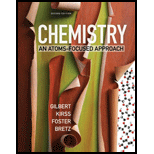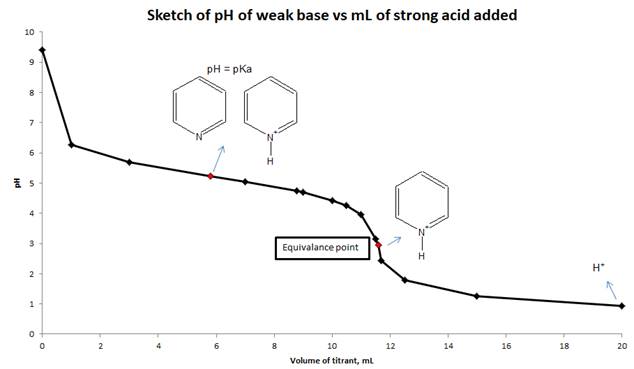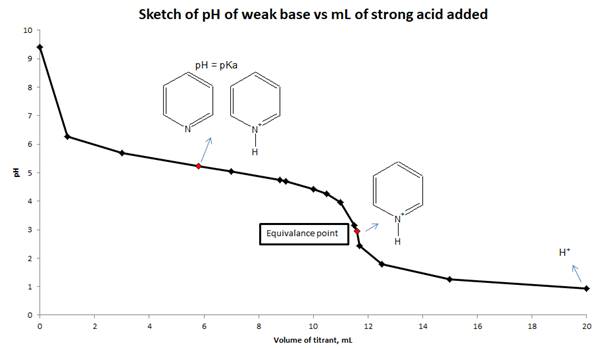
To find:
In the titration of pyridine and
a) The pH at equivalence point.
b) The best choice indicator for this titration.
c) The pH for the titration after different volumes.
d) Sketch the titration curve for this titration and indicate which major species are present in the solution when pH = pKa at equivalence point and at the end of titration.
Answer to Problem 16.127QA
Solution:
a) pH at equivalence point =
b) Methyl orange
c) At
d)

Explanation of Solution
1) Concept:
To calculate the pH of a weak base with a strong acid, we need to use reaction stoichiometry and RICE table. First, we will calculate the equivalence point from the volume and molarity of base and acid. We will calculate the pH at equivalence point by using RICE table. At equivalence point, moles of pyridine and HCl are the same, so the only species present is protonated pyridine. Using the hydrolysis of protonated pyridine and ICE table we can find the pH at the equivalence point. Suitable indicator for this titration is decided by comparing the pH at equivalence point and the pH range of indicators given in Figure 16.5. We will sketch the titration curve based on the pH of the solution and mL of a strong acid added to the weak base.
2) Formula:
i)
ii)
iii)
iv)
3) Given:
i) Concentration of pyridine =
ii) Volume of pyridine =
iii) Concentration of HCl =
iv)
v)
vi)
4) Calculations:
a) To calculate the equivalence point of the titration between pyridine and
From the balanced chemical equation, the mole ratio between pyridine and HCl is
At the equivalence point, moles of pyridine = moles of
Moles of
Volume of
The volume of
At equivalence point the number of moles of a weak base is equal to the number of moles of a strong acid. So, at the end of the reaction, the solution contains protonated pyridine which will govern the
| Initial | |||
| Added | |||
| Final | |||
We have the moles of the conjugate acid, hence, we can calculate the pH of the solution using the RICE table for protonated pyridine.
The dissociation reaction of protonated pyridine (conjugate acid) is written as:
Now calculating new molarity of conjugate acid as:
We can use RICE table to calculate the pH of the solution of conjugate acid.
| Initial | |||
| Change | |||
| Change | |||
Now write the
We will apply the 5% rule here, so we can ignore x from it,
The pH of the solution at equivalence point =
b) The pH of the solution at equivalence point =
c) Calculate the pH for the titration after following the volume of HCl added to a weak base.
1)
We can use RICE table to calculate the pH of the solution of pyridine at 0.0 mL addition of HCl
| Initial | |||
| Change | |||
| Equilibrium | |||
Now write the
We will apply the 5% rule here, so we can ignore x from it,
Initial pH of the pyridine =
2)
Calculate the moles of pyridine from 15.80 mL and 0.367 M.
Calculate the mole of HCl, when 1.0 mL added to the weak base.
We can use a modified RICE table to determine the how many moles of
| Initial | |||
| Change | |||
| Final | |||
The total sample volume is
Using these values in the Henderson–Hasselbalch equation gives us
3)
Calculate the mole of HCl, when
We can use a modified RICE table to determine the how many moles of
| Initial | |||
| Change | |||
| Final | |||
The total sample volume is
Using these values in the Henderson–Hasselbalch equation gives us
4)
Calculate the mole of HCl, when
We can use a modified RICE table to determine the how many moles of
| Initial | |||
| Change | |||
| Final | |||
The total sample volume is
Using these values in the Henderson–Hasselbalch equation gives us
5)
Calculate the mole of HCl, when
We can use a modified RICE table to determine the how many moles of
| Initial | |||
| Change | |||
| Final | |||
The total sample volume is
Using these values in the Henderson–Hasselbalch equation gives us
6)
Calculate the mole of HCl, when
We can use a modified RICE table to determine the how many moles of
| Initial | |||
| Change | |||
| Final | |||
The total sample volume is
Using these values in the Henderson–Hasselbalch equation gives us
7)
Calculate the mole of HCl, when
We can use a modified RICE table to determine the how many moles of
| Initial | |||
| Change | |||
| Final | |||
The total sample volume is
Using these values in the Henderson–Hasselbalch equation gives us
8)
Calculate the mole of HCl, when
We can use a modified RICE table to determine the how many moles of
| Initial | |||
| Change | |||
| Final | |||
The total sample volume is
Using these values in the Henderson–Hasselbalch equation gives us
9)
Calculate the mole of HCl, when
We can use a modified RICE table to determine the how many moles of
| Initial | |||
| Change | |||
| Final | |||
The total sample volume is
Using these values in the Henderson–Hasselbalch equation gives us
10)
Calculate the mole of HCl, when
We can use a modified RICE table to determine the how many moles of
| Initial | |||
| Change | |||
| Final | |||
HCl is a strong acid, the pH of solution can be calculated from the concentration of HCl.
The total sample volume is
11)
Calculate the mole of HCl, when
We can use a modified RICE table to determine the how many moles of
| Initial | |||
| Change | |||
| Final | |||
HCl is a strong acid, the pH of solution can be calculated from concentration of HCl.
The total sample volume is
12)
Calculate the mole of HCl, when
We can use a modified RICE table to determine the how many moles of
| Initial | |||
| Change | |||
| Final | |||
HCl is a strong acid, the pH of solution can be calculated from concentration of HCl.
The total sample volume is
13)
Calculate the mole of HCl, when
We can use a modified RICE table to determine the how many moles of
| Initial | |||
| Change | |||
| Final | |||
HCl is a strong acid, the pH of solution can be calculated from concentration of HCl.
The total sample volume is
d) Sketch the titration curve (pH vs mL of strong acid added) for this titration and show the major species are present in solution at pH = pka, equivalence point and end point.

Conclusion:
The pH of the solution is calculated from reaction stoichiometry and RICE table at different mL of the titrant added to the weak base and also calculated at equivalence point. Sketch drawn on the basis of pH values and volume of strong acid added to a weak base.
Want to see more full solutions like this?
Chapter 16 Solutions
CHEM:ATOM FOC 2E CL (TEXT)
- ● Biological Macromolecules Naming and drawing cyclic monosaccharides Your answer is incorrect. • Row 1: Your answer is incorrect. Row 3: Your answer is incorrect. • Row 4: Your answer is incorrect. Try again... 0/5 Give the complete common name, including anomer and stereochemistry labels, of the following molecules. You will find helpful information in the ALEKS resource. CH2OH OH OH H H I H OH OH H] H CH2OH H OH ẞ-L-sorbose HOCH2 OH OH H HOCH2 H OH OH H OH H H CH2OH OH H H OH H I- H OH H OH Explanation Recheck W E R % 25 α B Y X & 5 D F G H McGraw Hill LLC. All Rights Reserved. Terms of Use | Pr Parrow_forwardWhat is the missing reactant in this organic reaction? + R -A HO IN + H₂O Specifically, in the drawing area below draw the skeletal ("line") structure of R. If there is more than one reasonable answer, you can draw any one of them. If there is no reasonable answer, check the No answer box under the drawing area. Note for advanced students: you may assume no products other than those shown above are formed. Explanation Check Click and drag to start drawing a structure. © 2025 McGraw Hill LLC. All Rights Reserved. Terms of Use | Privacy Centerarrow_forwardStuc X ctclix ALE X A ALE אן A ALEX Lab (195 X Nut x M Inb x NU X NUT X Unt x + → C www-awu.aleks.com/alekscgi/x/Isl.exe/10_u-lgNslkr7j8P3jH-IQ1g8NUi-mObKa_ZLx2twjEhK7mVG6PulJI006NcKTV37JxMpZuyrVCdQolLAKqp_7U3r1GUD3... New Chrome available: Naomi Question 26 of 39 (4 points) | Question Attempt: 1 of Unlimited Give the IUPAC name. 2,3-dimethylhexane Part: 1/2 Part 2 of 2 Draw the skeletal structure of a constitutional isomer of the alkane above that contains a different number of carbons in its longest chain. Skip Part Check Click and drag to start drawing a structure. 3 Finance headline Q Search mwa Harvard Intensifi... X Save For Later 00 dlo HB Submit Assignment 2025 McGraw Hill LLC. All Rights Reserved. Terms of Use | Privacy Center | Accessibility a 9:11 PM 4/22/2025arrow_forward
- Predict the product of this organic reaction: + NH2 HO A P+ H2O Specifically, in the drawing area below draw the skeletal ("line") structure of P. If there is no reasonable possibility for P, check the No answer box under the drawing area. Click and drag to start drawing a structure. ✓arrow_forward个 Stuc X ctclix ALE X A ALE × A ALE X Lab x (195 × Nut x M Inbx EF 目 → C www-awu.aleks.com/alekscgi/x/Isl.exe/10_u-IgNslkr7j8P3jH-IQ1g8NUi-mObKa_ZLx2twjEhK7mVG6PulJI006NcKTV37JxMpz Chapter 12 HW = Question 27 of 39 (5 points) | Question Attempt: 1 of Unlimited Part: 1/2 Part 2 of 2 Give the IUPAC name. Check 3 50°F Clear ©2025 McGraw Hill L Q Search webp a عالياكarrow_forward个 Stuck x ctc xALE X A ALE × A ALE X Lab x (19: x - G www-awu.aleks.com/alekscgi/x/Isl.exe/10_u-lgNslkr7j8P3jH-1Q1g8NUi-mObka ZLx2twjEhK7mVG6PUUIO06 Chapter 12 HW 三 Question 26 of 39 (4 points) 1 Question Attempt: 1 of Unlimited Answer the following questions about the given alkane. Part: 0 / 2 Part 1 of 2 Give the IUPAC name. Skip Part 2 53°F Clear Check × Q Search hp hp 02arrow_forward
- Calculate the equilibrium constant at 25.0 oC for the following equation. Cd(s) + Sn+2(aq) ↔Cd+2(aq) + Sn(s) Group of answer choices 3.11x104 1.95x1018 9.66x108 1.40x109arrow_forwardWhat is the pH at the cathode for the following cell written in line notation at 25.0 oC with a Ecell = -0.2749 V? Ni(s)|Ni+2(aq, 1.00 M)||H+1(aq, ?M)|H2(g, 1.00 atm)|Pt(s)arrow_forwardCalculate Ecell for a hydrogen fuel cell at 95.0 oC using the following half-reactions with PH2 = 25.0 atm and PO2 = 25.0 atm. O2(g) + 4H+1(aq) + 4e-1 → 2H2O(l) Eo = 1.229 V 2H2(g) → 4H+1(aq) + 4e-1 Eo = 0.00 Varrow_forward
- Calculate Ecell at 25.0 oC using the following half-reactions with [Ag+1] = 0.0100 M and [Sn+2] = 0.0200 M. Ag+1(aq) + 1e-1 Ag(s) Sn+2(aq) + 2e-1 Sn(s)arrow_forwardDone 18:19 www-awu.aleks.com Chapter 12 HW Question 27 of 39 (5 points) | Question Attempt: 1 of Unlimited .. LTE סוי 9 ✓ 20 ✓ 21 × 22 23 24 25 26 27 28 29 30 Answer the following questions about the given alkane. Part: 0 / 2 Part 1 of 2 Classify each carbon atom as a 1º, 2º, 3º, or 4°. Highlight in red any 1° carbons, highlight in blue any 2° carbons. highlight in green any 3° carbons, and leave any 4° carbons unhighlighted. Skip Part Check Save For Later © 2025 McGraw Hill LLC. All Rights Reserved. Terms of Use Privacy Center | Accessibility ☑ คarrow_forward< Done 19:22 www-awu.aleks.com Chapter 12 HW Question 4 of 39 (2 points) | Question Attempt: 5 of Unlimited : .. LTE סוי 1 ✓ 2 ✓ 3 = 4 ✓ 5 ✓ 6 ✓ 7 ✓ 8 ✓ 9 = 10 11 ✓ 12 Consider the molecule (CH3)2CHCH2CHCн for the following questions. Part 1 of 2 Which of the following molecules is/are constitutional isomer(s) to (CH3)2CHCH2CH2CH3? Check all that apply. Part 2 of 2 (CH3),C(CH2)2CH3 CH3 H,C-CH-CH-CH, CH 3 None of the above. ☑ Which of the following molecules is/are identical molecules to (CH3)2CHCH2CH2CH₁₂? Check all that apply. CH3 H,C-CH-CH₂-CH2-CH, CH3(CH2)2CH(CH3)2 CH2-CH2-CH3 HỌC-CH=CH, 乂 ☑ а None of the above Check Save For Later Submit Assignment © 2025 McGraw Hill LLC. All Rights Reserved. Terms of Use | Privacy Center Accessibilityarrow_forward
 ChemistryChemistryISBN:9781305957404Author:Steven S. Zumdahl, Susan A. Zumdahl, Donald J. DeCostePublisher:Cengage Learning
ChemistryChemistryISBN:9781305957404Author:Steven S. Zumdahl, Susan A. Zumdahl, Donald J. DeCostePublisher:Cengage Learning ChemistryChemistryISBN:9781259911156Author:Raymond Chang Dr., Jason Overby ProfessorPublisher:McGraw-Hill Education
ChemistryChemistryISBN:9781259911156Author:Raymond Chang Dr., Jason Overby ProfessorPublisher:McGraw-Hill Education Principles of Instrumental AnalysisChemistryISBN:9781305577213Author:Douglas A. Skoog, F. James Holler, Stanley R. CrouchPublisher:Cengage Learning
Principles of Instrumental AnalysisChemistryISBN:9781305577213Author:Douglas A. Skoog, F. James Holler, Stanley R. CrouchPublisher:Cengage Learning Organic ChemistryChemistryISBN:9780078021558Author:Janice Gorzynski Smith Dr.Publisher:McGraw-Hill Education
Organic ChemistryChemistryISBN:9780078021558Author:Janice Gorzynski Smith Dr.Publisher:McGraw-Hill Education Chemistry: Principles and ReactionsChemistryISBN:9781305079373Author:William L. Masterton, Cecile N. HurleyPublisher:Cengage Learning
Chemistry: Principles and ReactionsChemistryISBN:9781305079373Author:William L. Masterton, Cecile N. HurleyPublisher:Cengage Learning Elementary Principles of Chemical Processes, Bind...ChemistryISBN:9781118431221Author:Richard M. Felder, Ronald W. Rousseau, Lisa G. BullardPublisher:WILEY
Elementary Principles of Chemical Processes, Bind...ChemistryISBN:9781118431221Author:Richard M. Felder, Ronald W. Rousseau, Lisa G. BullardPublisher:WILEY





